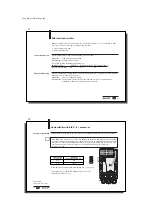
11
deutsch
11
E
Address setting is done on the module (not on the I/O modules, i.e. not on the BIS C-60_1
processor). There are two types of addressing possible:
1. logical addressing, and
2. physical addressing.
Logical addressing permits free addressing of each module.
Advantage:
high security and flexibility;
Disadvantage: more difficult at setup.
For the BIS C-60_1 Identification System use:
I/O Module Type
IDENT-No.
IN-Address (Byte)
OUT-Address (Byte)
Processor BIS C-60_1
03
16
16
Physical addressing is rigidly fixed to the system configuration. The address of each module
depends on its location in the system.
Advantage:
easy to configure at setup;
Disadvantage: changes in module location when power was off are recognized upon
initialization, but are not made known to the user.
BUS interface: I
NTER
B
US
Physical Addressing
Logical Addressing
C60_1-023_819395_0508_en.p65
12
12
E
1
2
3
Compatibility with BIS C-6_1 processor
Setting compatibility
Compatibility with the BIS C-6_1 processors is established using terminal X5 and a jumper.
If the BIS C-60_1 processor is set to be compatible with the BIS C-601 or BIS C-621, all settings
for data exchange must be made as described in the sections on parametering, function descrip-
tion, protocol sequence and LED display in the user’s manual for the BIS C-6_1 processor! This
user’s manual can be mailed on request, or you may download it from the Internet at
www.balluff.de
.
19 18 17 16 15 14 13 12 11 10 9 8 7 6 5 4 3 2 1
X5
Head 1
Head 2
Terminal X5
(with cover removed)
➪
Jumper setting
Terminal X5
Processor
compatible with BIS C-6_1
1-2
no
2-3
yes
In the illustration compatibility with the BIS C-6_1 is not set.
To open the cover of the BIS C-6001 processor, see 61,
and for BIS C-6021 see 74.
☞
















































